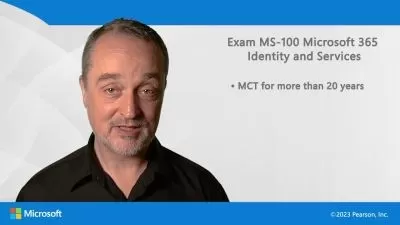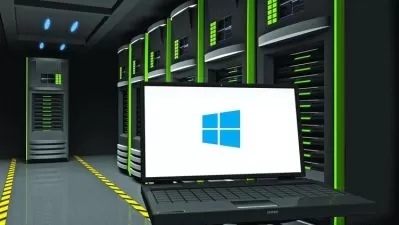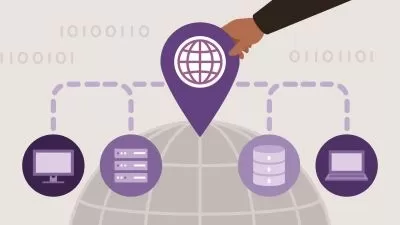AZ-801 Configuring Windows Server Hybrid Advanced Services
John Christopher
14:44:25
Description
Get prepared for the AZ-801 exam with instructor led labs and hands on simulations available 24/7
What You'll Learn?
- Learn the concepts and perform hands on activities needed to pass the AZ-801 exam
- Gain a tremendous amount of knowledge involving Windows Server, Microsoft 365 and Azure Services
- Get loads of hands on experience with Microsoft Windows Server, Microsoft 365 / Azure Services
- Utilize hands on simulations that can be access anytime, anywhere!
Who is this for?
More details
DescriptionWe really hope you'll agree, this training is way more than the average course on Udemy!
Have access to the following:
Training from an instructor of over 20 years who has trained thousands of people and also a Microsoft Certified Trainer
Lecture that explains the concepts in an easy to learn method for someone that is just starting out with this material
Instructor led hands on and simulations to practice that can be followed even if you have little to no experience
TOPICS COVEREDÂ INCLUDINGÂ HANDSÂ ONÂ LECTUREÂ ANDÂ PRACTICEÂ TUTORIALS:
Introduction
Welcome to the course
Understanding the Microsoft Environment
Having a Solid Foundation of Active Directory Domains
Having a Solid Foundation of RAS, DMZ, and Virtualization
Having a Solid Foundation of the Microsoft Cloud Services
IMPORTANT Using Assignments in the course
Setting up for hands on
This is a follow up from the AZ-800
Introduction to practicing hands on
Downloading Windows Server 2022 ISO
Getting Hyper-V Installed on Windows
Creating a Virtual Switch in Hyper-V
Installing a Windows Server 2022 Virtual Machine
Installing a second Windows Server 2022 Virtual Machine
Downloading the Windows 11 ISO
Installing a Windows 11 virtual machine
Deploy and manage domain controllers on-premises
Joining a server to a domain
Joining Windows 11 to a domain
Creating a trial Microsoft 365/Azure Account
Adding a subscription to your Azure account
Connect your On-Premise ADDS Domain to Azure AD using Azure AD Connect
Secure Windows Server operating system
Configure and manage exploit protection
Configure and manage Windows Defender Application Control
Activating a free trial for Windows Defender for Endpoint
Configure and manage Windows Defender for Endpoint
Configure and manage Windows Defender Credential Guard
Configure SmartScreen
Implement operating system security by using Group Policies
Secure a hybrid Active Directory (AD) infrastructure
Configure password policies
Enable password block lists
Manage protected users
Manage account security on a Read-Only Domain Controller (RODC)
Harden domain controllers
Configure authentication policies silos
Restrict access to domain controllers
Configure account security
Manage AD built-in administrative groups
Manage AD delegation
Implement and manage Microsoft Defender for Identity
Identify and remediate Windows Server security issues by using Azure services
Monitor on-premises servers & Azure IaaS VMs by using Microsoft Sentinel
Identify & remediate security issues on-premises servers & VMs by using Defender for Cloud
Secure Windows Server networking
Manage Windows Defender Firewall
Implement domain isolation and connection security rules
Secure Windows Server storage
Manage Windows BitLocker Drive Encryption (BitLocker)
Manage and recover encrypted volumes
Enable storage encryption by using Azure Disk Encryption
Manage disk encryption keys for IaaS virtual machines
Implement a Windows Server failover cluster
Implement a failover cluster on-premises, hybrid, or cloud-only
Configure storage for failover clustering
Create a Windows failover cluster
Stretch cluster across datacenter or Azure regions
Modify quorum options
Configure network adapters for failover clustering
Configure cluster workload options
Configure cluster sets
Configure Scale-Out File Server
Create an Azure witness
Visualizing floating IP address and load balancing for failover clusters
Manage failover clustering
Implement cluster-aware updating for installing updates on node
Recover a failed cluster node and failover workloads between nodes
Upgrade a node to Windows Server 2022
Manage failover clusters using Windows Admin Center
Implement and manage Storage Spaces Direct
Create and configure storage spaces
Understanding storage spaces direct
Manage backup and recovery for Windows Server
Back up and restore files and folders to Azure Recovery Services vault
Install and manage Azure Backup Server
Back up and recover using Azure Backup Server
Manage backups in Azure Recovery Services vault
Create a backup policy
Configure backup for Azure Virtual Machines using the built-in backup agent
Recover a VM using temporary snapshots
Recover VMs to new Azure Virtual Machines
Restore a VM
Implement disaster recovery by using Azure Site Recovery
Understanding Azure Site Recovery
Configure Azure Site Recovery networking
Understanding recovery plans
Cleaning up to save Azure credit
Configure Site Recovery for Azure Virtual Machines and on premise VMs
Implement VM replication to secondary datacenter or Azure region
Configure Azure Site Recovery policies
Protect virtual machines by using Hyper-V replicas
Configuring your Hyper-V host with nested virtualization to support replication
Configure and manage Hyper-V replica's
Migrate on-premises storage to on-premises servers or Azure
Transfer and Migrate data to Azure file shares
Cut over to a new server by using Storage Migration Service (SMS)
Basics of using Storage Migration Service to migrate to Azure VMs
Migrate on-premises servers to Azure
Overview of Azure Migration
Configure an Azure Migration Project
Installing an Azure Migration appliance virtual machine
Perform an Azure Migration discovery using a Migration appliance
Creating an assessment using Azure Migration
Removing AD from a DC in order to perform migration
Migrate by using Azure Migrate
Migrate workloads from previous versions to Windows Server 2022, IIS workloads, & AD DS
Understanding migration of IIS, Hyper-V, RDS, DHCP, and print services
Installing the Windows Server Migration tool
Overview of App Service Plans
Migrate IIS workloads to Azure Web Apps
Overview of Azure Containers
Migrate IIS workloads to containers
Migrate AD DS objects using Active Directory Migration Tool
Monitor Windows Server by using Windows Server tools and Azure services
Monitor Windows Server by using Performance Monitor
Create and configure Data Collector Sets
Monitor servers by using Windows Admin Center
Monitor by using System Insights
Manage event logs
Deploy Log Analytics agents
Collect performance counters to Azure
Create alerts
Monitor Azure Virtual Machines by using Azure diagnostics extension
Monitor Azure Virtual Machines performance by using VM insights
Troubleshoot Windows Server on-premises and hybrid networking
Troubleshoot hybrid network connectivity
Troubleshoot on-premises connectivity with Azure
Troubleshoot Windows Server virtual machines in Azure
Troubleshoot deployment failures
Troubleshoot booting failures
Troubleshoot VM performance issues
Troubleshoot VM extension issues
Troubleshoot disk encryption issues
Troubleshoot storage
Troubleshoot VM connection issues
Troubleshoot Active Directory
Restore objects from AD recycle bin
Recover Active Directory database using Directory Services Restore Mode
Recover SYSVO
Troubleshoot Active Directory replication
Troubleshoot hybrid authentication issues
Troubleshoot on-premises Active Directory
Finishing Up
BONUSÂ Where do I go from here?
Who this course is for:
- IT people interested in learning and passing the Microsoft AZ-801 exam!
- IT people interested in learning a tremendous amount about Windows Server, Microsoft 365 and Azure Services!
We really hope you'll agree, this training is way more than the average course on Udemy!
Have access to the following:
Training from an instructor of over 20 years who has trained thousands of people and also a Microsoft Certified Trainer
Lecture that explains the concepts in an easy to learn method for someone that is just starting out with this material
Instructor led hands on and simulations to practice that can be followed even if you have little to no experience
TOPICS COVEREDÂ INCLUDINGÂ HANDSÂ ONÂ LECTUREÂ ANDÂ PRACTICEÂ TUTORIALS:
Introduction
Welcome to the course
Understanding the Microsoft Environment
Having a Solid Foundation of Active Directory Domains
Having a Solid Foundation of RAS, DMZ, and Virtualization
Having a Solid Foundation of the Microsoft Cloud Services
IMPORTANT Using Assignments in the course
Setting up for hands on
This is a follow up from the AZ-800
Introduction to practicing hands on
Downloading Windows Server 2022 ISO
Getting Hyper-V Installed on Windows
Creating a Virtual Switch in Hyper-V
Installing a Windows Server 2022 Virtual Machine
Installing a second Windows Server 2022 Virtual Machine
Downloading the Windows 11 ISO
Installing a Windows 11 virtual machine
Deploy and manage domain controllers on-premises
Joining a server to a domain
Joining Windows 11 to a domain
Creating a trial Microsoft 365/Azure Account
Adding a subscription to your Azure account
Connect your On-Premise ADDS Domain to Azure AD using Azure AD Connect
Secure Windows Server operating system
Configure and manage exploit protection
Configure and manage Windows Defender Application Control
Activating a free trial for Windows Defender for Endpoint
Configure and manage Windows Defender for Endpoint
Configure and manage Windows Defender Credential Guard
Configure SmartScreen
Implement operating system security by using Group Policies
Secure a hybrid Active Directory (AD) infrastructure
Configure password policies
Enable password block lists
Manage protected users
Manage account security on a Read-Only Domain Controller (RODC)
Harden domain controllers
Configure authentication policies silos
Restrict access to domain controllers
Configure account security
Manage AD built-in administrative groups
Manage AD delegation
Implement and manage Microsoft Defender for Identity
Identify and remediate Windows Server security issues by using Azure services
Monitor on-premises servers & Azure IaaS VMs by using Microsoft Sentinel
Identify & remediate security issues on-premises servers & VMs by using Defender for Cloud
Secure Windows Server networking
Manage Windows Defender Firewall
Implement domain isolation and connection security rules
Secure Windows Server storage
Manage Windows BitLocker Drive Encryption (BitLocker)
Manage and recover encrypted volumes
Enable storage encryption by using Azure Disk Encryption
Manage disk encryption keys for IaaS virtual machines
Implement a Windows Server failover cluster
Implement a failover cluster on-premises, hybrid, or cloud-only
Configure storage for failover clustering
Create a Windows failover cluster
Stretch cluster across datacenter or Azure regions
Modify quorum options
Configure network adapters for failover clustering
Configure cluster workload options
Configure cluster sets
Configure Scale-Out File Server
Create an Azure witness
Visualizing floating IP address and load balancing for failover clusters
Manage failover clustering
Implement cluster-aware updating for installing updates on node
Recover a failed cluster node and failover workloads between nodes
Upgrade a node to Windows Server 2022
Manage failover clusters using Windows Admin Center
Implement and manage Storage Spaces Direct
Create and configure storage spaces
Understanding storage spaces direct
Manage backup and recovery for Windows Server
Back up and restore files and folders to Azure Recovery Services vault
Install and manage Azure Backup Server
Back up and recover using Azure Backup Server
Manage backups in Azure Recovery Services vault
Create a backup policy
Configure backup for Azure Virtual Machines using the built-in backup agent
Recover a VM using temporary snapshots
Recover VMs to new Azure Virtual Machines
Restore a VM
Implement disaster recovery by using Azure Site Recovery
Understanding Azure Site Recovery
Configure Azure Site Recovery networking
Understanding recovery plans
Cleaning up to save Azure credit
Configure Site Recovery for Azure Virtual Machines and on premise VMs
Implement VM replication to secondary datacenter or Azure region
Configure Azure Site Recovery policies
Protect virtual machines by using Hyper-V replicas
Configuring your Hyper-V host with nested virtualization to support replication
Configure and manage Hyper-V replica's
Migrate on-premises storage to on-premises servers or Azure
Transfer and Migrate data to Azure file shares
Cut over to a new server by using Storage Migration Service (SMS)
Basics of using Storage Migration Service to migrate to Azure VMs
Migrate on-premises servers to Azure
Overview of Azure Migration
Configure an Azure Migration Project
Installing an Azure Migration appliance virtual machine
Perform an Azure Migration discovery using a Migration appliance
Creating an assessment using Azure Migration
Removing AD from a DC in order to perform migration
Migrate by using Azure Migrate
Migrate workloads from previous versions to Windows Server 2022, IIS workloads, & AD DS
Understanding migration of IIS, Hyper-V, RDS, DHCP, and print services
Installing the Windows Server Migration tool
Overview of App Service Plans
Migrate IIS workloads to Azure Web Apps
Overview of Azure Containers
Migrate IIS workloads to containers
Migrate AD DS objects using Active Directory Migration Tool
Monitor Windows Server by using Windows Server tools and Azure services
Monitor Windows Server by using Performance Monitor
Create and configure Data Collector Sets
Monitor servers by using Windows Admin Center
Monitor by using System Insights
Manage event logs
Deploy Log Analytics agents
Collect performance counters to Azure
Create alerts
Monitor Azure Virtual Machines by using Azure diagnostics extension
Monitor Azure Virtual Machines performance by using VM insights
Troubleshoot Windows Server on-premises and hybrid networking
Troubleshoot hybrid network connectivity
Troubleshoot on-premises connectivity with Azure
Troubleshoot Windows Server virtual machines in Azure
Troubleshoot deployment failures
Troubleshoot booting failures
Troubleshoot VM performance issues
Troubleshoot VM extension issues
Troubleshoot disk encryption issues
Troubleshoot storage
Troubleshoot VM connection issues
Troubleshoot Active Directory
Restore objects from AD recycle bin
Recover Active Directory database using Directory Services Restore Mode
Recover SYSVO
Troubleshoot Active Directory replication
Troubleshoot hybrid authentication issues
Troubleshoot on-premises Active Directory
Finishing Up
BONUSÂ Where do I go from here?
Who this course is for:
- IT people interested in learning and passing the Microsoft AZ-801 exam!
- IT people interested in learning a tremendous amount about Windows Server, Microsoft 365 and Azure Services!
User Reviews
Rating
John Christopher
Instructor's Courses
Udemy
View courses Udemy- language english
- Training sessions 125
- duration 14:44:25
- Release Date 2023/02/06
















